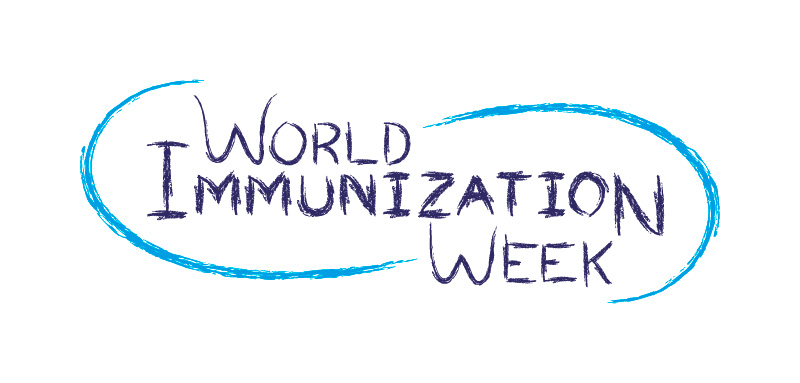
April | 24, 2018 :: World Immunization Week (24 – 30 April) is a key global moment that re-focuses attention on the importance of vaccination for children
World Immunization Week draws attention to the linkages between immunization and newborn and child survival and health and is celebrated every year from 24 to 30 April. This year the theme for World Immunization Week will be “Protected Together, #VaccinesWork”. This theme draws attention to the shared responsibility for vaccination, positioning vaccines as a shield that protects children, families, and communities and particularly the most vulnerable – newborn babies. The week will emphasize the fact that, while significant progress has been made in reaching more children with life-saving vaccines, an estimated 1.5 million children still die from vaccine preventable diseases every year. This is unacceptable in a world where safe, affordable life-savings vaccines exist.
Globally 1 in 7 children – over 19 million – missed out on routine vaccines, including 13 million who have never been vaccinated, putting them and their communities at risk of disease and death. Low immunization coverage compromises gains in all other areas of health for mothers and children. The poorest, most vulnerable children who need immunization the most continue to be the least likely to get it.
Routine Immunization Programme in India
Routine immunization programme in India has come a long way since the inception of the Universal Immunization program in 1985 with vaccination provided against 6 vaccine preventable diseases (BCG, DPT, OPV & Measles). Today, the Universal Immunization Programme (UIP) provides vaccination against ten vaccine preventable childhood diseases (Diphtheria, Whooping cough, Tetanus, Polio, Tuberculosis, Measles and Hepatitis B, Pneumonia, Meningitis and Rotavirus). UIP is the most cost effective strategy to reduce vaccine preventable diseases and deaths in children.
10 Key facts on vaccination/immunization in India & Jharkhand
1. India has seen a significant increase in the number of vaccinated children since 2010, driving most of the gains in immunization coverage this decade. In India, the number of unvaccinated children reduced by 45 per cent, from 5.3 million in 2010 to 2.9 million in 2016.
2. India with 9% is one of the top 10 countries where vaccination coverage*, in percentage points, has increased between 2010 and 2016.
3. As of 2016, out of the six countries India accounted for 15% of the world’s unimmunized children
4. Small pox and Polio have been eradicated and maternal & neonatal tetanus eliminated from India. There has been an 80% reduction in the number of reported cases of Diptheria, Measles and Pertusis.
5. Almost 9 million routine immunization (RI) sessions are organized in India each year where 26 million children and 30 million pregnant women are immunized. This is supported by a network of 27,000 cold chain points where these vaccines are stored.
6. Sustaining high coverage of immunization is critical to reduce the burden of vaccine preventable diseases. India has shown tremendous progress in achieving full immunization coverage which has gone up from 43.5% in 2005-2006 (NFHS 3) to 62% in 2015-2016 (NFHS 4).
7. In Jharkhand, immunization coverage has gone up to 61.9% (NFHS-4) from 34.2% 2005-2006 (NFHS 3). Jharkhand has done well to reduce under five mortality by almost 40% (an estimated 16,500 under five children saved) and infant mortality by more than 25% (SRS 2011-16).
8. An estimated 300,000 infants in Jharkhand are still missing out on basic vaccines. Recent evaluations have indicated that the major reasons for no immunization or partial immunization are a lack of awareness among parents about the benefits of vaccination, fear of adverse events following immunization and operational reasons such as non-availability of vaccines or vaccinators during immunization sessions. Reaching out to these children would be necessary if we have to achieve immunization coverage of more than 90%.
9. Mission Indradhanush (MI) 4 Phases were conducted in Jharkhand from April 2015 to July 2017 to cover children who were left out or had dropped out from the immunization program. To reach every child, the campaign covered children in urban slums, nomadic sites, brick kilns, construction sites , other migrant settlements (fisherman villages, riverine areas with shifting populations, etc.) and underserved and hard-to-reach populations (forested and tribal populations, etc).
10. Though there has been significant improvement, much needs to be done. Statistically, children in rural areas are least likely to be fully immunized. This inequity is most pronounced in states like Madhya Pradesh, Rajasthan, Chhattisgarh, Jharkhand, and Uttar Pradesh (NFHS 4).
New Initiatives
Gram Swaraj Abhiyaan: As part of the Gram Swaraj Abhiyaan, the Department of Health, Government of Jharkhand will be conducting Mission Indradhanush rounds in 252 villages across 21 districts in the state with poor immunization indicators with the aim to achieve 100% immunization in these poor performing villages.
Measles & Rubella (MR) Campaign: The Department of Health, Government of Jharkhand will introduce the Measles & Rubella (MR) vaccine in the state in June-July 2018. This 4-week long MR campaign will cover 1.3 crore children (9 months – 15 years) both in and out of school in the state.

